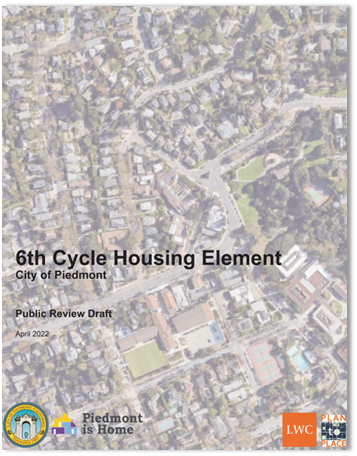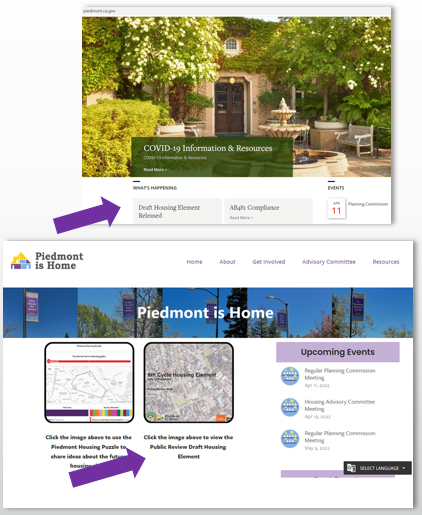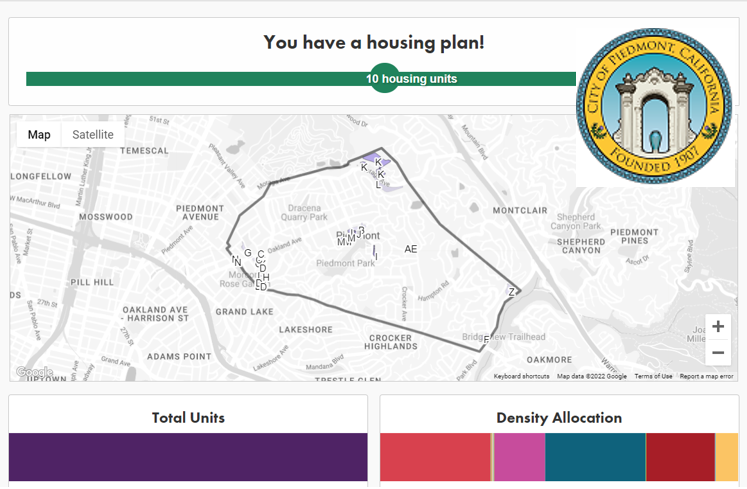While a lot of work has been done on the Housing Element, some significant changes to the sites inventory are needed to ensure compliance with State laws and community objectives. In particular, the element fails to include a single realistic site that would be available for construction of lower-income housing over the next several years.
Additionally, the City’s proposal to locate majority of its housing, including all affordable housing, on currently non-surplus public sites (as defined under State law), many actively used for civic and recreational uses (e.g., police station, Veterans Hall, tennis courts) is highly unusual, and perhaps unique among hundreds of California cities. This would encumber the City with obligations post-adoption it may struggle to meet, resulting in highly messy implementation, significant financial burdens, and potential loss of civic facilities and parks, even if this strategy passes muster with the State.
I will first start with some easy opportunities that should be captured, followed by a discussion of the some of the items raised above.
1. COUNT ALLOWABLE SITES CURRENTLY NOT INCLUDED IN THE INVENTORY
The Housing Element currently fails to reflect housing and sites allowed to be counted under State laws, which should be included in the sites inventory, and would put some dent in remaining housing needs:
Housing for which certificate of occupancy will be issued July 1, 2022 to Jan. 31, 2023
These are not included in the current draft of the Housing Element, as it seems from the June 6th community workshop, that the City’s consultant was unaware of this provision. This stems from the difference in the Housing Element Planning Period (which starts January 2023) and the regional data Projection Period (which starts July 1, 2022). The State HCD reference to this has been provided to staff and hopefully this will be corrected in the next draft of the Housing Element. https://www.hcd.ca.gov/community-development/housing-element/docs/6th-web-he-duedate.pdf. At the current pace of development, this would likely be 12 to 15 units, but City staff should have precise building permitting data.
SB-9 Units
It’s a bit puzzling why these have been left out of consideration for housing sites. City staff mentioned at the public workshop that housing built under SB-9 would be reflected in the City’s Housing Element annual progress reports as achievements following adoption, but including this now would help the City meet a portion of its housing needs. Several Southern California jurisdictions have used SB-9 without running into issues with the State Department of Housing and Community Development (HCD), and Bay Area cities such as Mill Valley, Larkspur, and Ross are using these as well. SB-9 has both a lot split and a non lot-split component. However, rules (e.g., direct street access from a new lot to street) need to be spelled out by cities, and Piedmont has not done so yet. Actual yield would need to be calculated using Geographic Information Systems calculations, but a guess is that 40 to 50 units from this could result.
2. PROVIDE MEANINGFUL LOWER-INCOME HOUSING OPPORTUNITIES
The draft Housing Element fails to make available any realistic sites for affordable housing, as required under State law. All lower income sites are located on City-owned land, none of which is surplus. I am not aware of any other city in California that is doing this, especially for the entirety of its lower-income housing program. The Civic Center sites are unrealistic (see below) and the Housing Element would require preparation of a Specific Plan for the Moraga Canyon sites, adoption of which is a discretionary City Council action, and thus there is no certainty that this will happen, and even if it does, would certainly push out site availability by several years. Thus, the City’s commitment to lower-income housing is questionable.
3. REMOVE CIVIC CENTER SITES AS THESE ARE UNREALISTIC FOR HOUSING AND HAVE POTENTIAL TO GENERATE MASSIVE PROBLEMS FOR CITY POST HOUSING ELEMENT ADOPTION
The Housing Element has sites in the Civic Center area that are actively used for civic and recreational uses (e.g., police station, Veterans Hall, tennis courts), and Highland Green. There are no details in the Housing Element of housing will result on these sites. There are some real practical problems – e.g., the cost to rehab and seismically retrofit Veterans Hall and the Police Building alone was estimated by the City at $15 million to $20 million two years ago, and the City decided not to place these together with pool reconstruction on the bond ballot measure at the same time. So currently there is no funding for these. If housing is built together with these facilities, these facilities will need to be replaced, not just rehabbed, at significantly higher costs, which may be several multiples of the rehab cost. The City does not have money to rehab these facilities, let alone build new ones. Housing on top of these structures would also be much more expensive to build and be unlikely for even market-rate housing, let alone for affordable housing.
Additionally, there are legal uncertainties. The City Charter does not permit reclassification of existing zones, and going from allowing one single-family unit per site in the Civic Center area to higher density housing at 60 or 80 units per acre is reclassification of Public zone to Public/Residential for all practical purposes, regardless of whether the zone title is changed. The City also cannot commit any monies to affordable housing under the California constitution, without a vote of the people (as example, Oakland has a ballot measure in place for November asking the voters to authorize this).
It should be noted that following the demise of redevelopment which provided monies for affordable housing to cities, State law was changed to allow cities to use a minimum “default density” as a proxy for affordable housing. In the Bay Area/Piedmont, this is 30 units per acre. So while housing elements may have sites at densities higher than this as having potential for income-restricted housing, in practice, it is rare for these sites get developed with affordable housing, as these require subsidies and assembling of financing packages, that are often difficult to cobble together. The higher densities do facilitate development of market-rate workforce and senior housing, so these sites do serve a useful purpose.
Because the City is the owner of the sites where the lower-income sites are shown, it would be incumbent upon the City to demonstrate how lower-income (that is, income-restricted) housing would result, in more detail in the Housing Element. The City needs to lay out this roadmap in the element to satisfy the State. Later, say when the City is ready to move along with rehabbing Veterans Hall, it would need to wait for a housing partner. The City may need to issue RFPs to attract developers, convince the State that no developers were found if that is the case, and have to find other sites to zone under new State laws passed in 2018, which means starting over.
This approach is so fraught with potential problems, that I don’t readily know of any city in California that is doing this as part of their Housing Element inventories, not even cities with a lot more dedicated staff and resources or huge commitments to housing. While this may seem like an easy way to find sites and get the Housing Element certified, the real problems will emerge and consume the City for the several years AFTER the Housing Element is adopted and certified, and present problems that the City may find hard to extricate itself from.
The City should remove these sites from further consideration in the Housing Element, especially as it is possible to meet both lower-income and overall housing needs through other methods.
4. REMOVE HIGHLAND GREEN FROM CONSIDERATION
The City should also remove Highland Green from consideration as a housing site. This site has a total of five paltry units capacity as per the Housing Element (which is a lot less than the SB-9 units the City believes it doesn’t need to count), is used for July 4th parade staging, and is barely 25 feet deep, and unsuited for housing. Piedmont also is short on parks and recreation space, and the EIR on the Housing Element will likely show a significant and unavoidable park impact with the addition of new housing, requiring the City to undertake all feasible measures to mitigate these impacts under the California Environmental Quality Act (CEQA).
5. REMOVE REQUIREMENT OF SPECIFIC PLAN FOR MORAGA CANYON DEVELOPMENT
A requirement of a Specific Plan as a prelude to any development in this area will delay development. This is also unnecessary, as utilities are available at the site and the City can apportion areas here easily for housing development to enable development to proceed. The City is already required under State law to prepare objective housing design standards, which could be tailored for the area.
6. DESIGNATE ONE OF THE TWO GRAND AVENUE SITES FOR LOWER-INCOME HOUSING
The Housing Element designates Ace Hardware and Sylvan office building for moderate and higher income housing. These sites are within the acreage (0.5 acres to 10.0 acres) range that HCD recommends for lower-income housing, and should be designated for these instead of Civic Center sites. Development at these sites will likely take place by razing the existing buildings, and housing can be easily incorporated as part of redevelopment. Regardless, it will up to the market to perform development here–whether it’s affordable, market rate, or senior–rather than encumbering the City with this responsibility.
7. CONSIDER HIGHER DENSITIES ALONG GRAND AVENUE AND HIGHLAND AVENUE TO MAKE UP SHORTFALL RESULTING FROM REMOVAL OF CIVIC CENTER SITES
The proposed densities of 80 units per acre along Grand and Highland avenues are low, and can be increased to 120 or 140 units per acre, within five stories. For context, much of the new development along Broadway in Oakland in Broadway Valdez area are at about three times this density. The new six-story residential building with a 35,000 s.f. Target store and other commercial uses Broadway/26th is at 240 units per acre, in a seven-story configuration (six stories residential above commercial). Half this much density, especially along Grand Avenue, is not unreasonable. This a great area, walkable, with access to stores, school, and amenities.
Calculation of how increase in density at Grand Avenue to 140 units per acre max. and Highland sites to 100 units per acre would result in the same number of units after removal of Civic Center sites has been provided to the City. It should be noted that were SB-9 units to be counted, the proposed Highland Avenue densities can be left as proposed in the Housing Element (80 units per acre), and Grand Avenue densities increased to 120 units per acre.
8. ADDITIONAL ITEMS FOR CONSIDERATION
Promoting Missing Middle Housing
The Housing Element does not consider strategies to foster a greater variety of housing types (for examples triplexes, fourplexes) in some or all single-family areas. This may run afoul of the City Charter, but is a strategy worth considering, and is much less of a change from the City Charter than what is being considered for the Public zone in the draft element. The City can maintain the existing development regulations (pertaining to setbacks, heights, floor area ratios) to ensure that these blend in into existing neighborhoods.
Consideration of Walkability and Access to Amenities
The draft Housing Element has a lot of housing units (132) squeezed into a relatively small area at the Corp Yard site. This area does not have the same access to stores, services, and transit as the Grand Avenue area, yet the highest densities (80 units per acre max.) are the same in the two areas. This number should be reduced, and more housing accommodated along Grand and Highland avenues. The City may also find that less development is needed here once SB-9 sites are counted.
Rajeev Bhatia, Piedmont Resident










